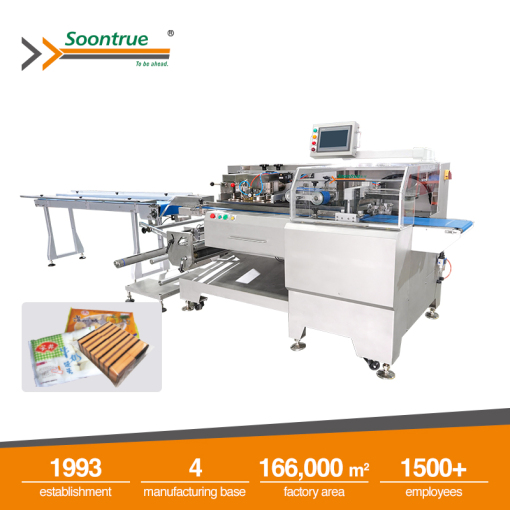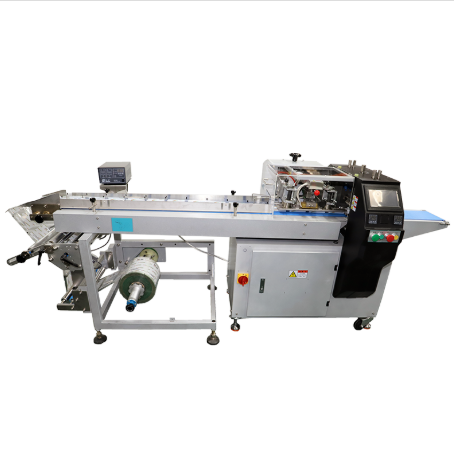Flow Packing Machine | Rotary & Box Motion Flow Wrappers by Soontrue
1. What is a Flow Packing Machine?
A flow packing machine forms a tube of film around a product traveling horizontally, seals it longitudinally, and makes cross seals at the ends to produce a pillow, wrapped, or sealed package. Flow wrappers can be continuous high-speed machines or modular units for lower volumes. They are typically referred to as horizontal flow wrappers (HFFS).
2. Types of Flow Packing Machines
2.1 Rotary Motion Flow Packaging Machine
2.1.1 How rotary motion works
Rotary flow wrappers use a continuously rotating jaw assembly to make the cross-seal. Film is formed into a tube around the product, and the rotating jaw clamps and cuts at high speed to create end seals. This rotating action enables very high throughput because seals are made in a continuous rotary motion.
2.1.2 Advantages & typical applications
Excellent for high output (snack bars, candy, single-serve foods).
Suitable for smaller to medium product lengths with consistent geometry.
Often has simpler mechanical architecture for ultra-high speed lines.
2.2 Box Motion Flow Packaging Machine
2.2.1 How box motion works
Box motion machines move cross-seal jaws in a linear “box” pattern so the jaw closes, remains engaged (dwell) while sealing, then opens and ejects the pack. That linear motion gives longer dwell time on the seal area, which improves seal integrity for thicker films, processed foods, or products that require hermetic sealing.
2.2.2 Advantages & typical applications
Ideal for taller, longer or irregular products (large cuts of protein, long bakery items).
Better for heavy gauge film or when extended dwell time is needed for a reliable hermetic seal.
Often chosen where seal quality and package integrity outweigh marginal differences in top speed.
3. Key components of a flow wrap packing line
Understanding these components helps you specify the right machine and evaluate Soontrue models vs competitors.
3.1 Film unwind & forming tube
Film reels are mounted on the machine and guided into a forming collar or tube that shapes film around the product. Quick reel change and precise film tracking matter for uptime and consistent packaging.
3.2 Infeed, product handling & timing screws
Product alignment, feeding (single lane or multi-lane), and product stabilization (chicanes, timing screws, belts) are crucial for accurate placement and seal quality.
3.3 Longitudinal seal, cross-seal (rotary/box jaws) and dwell time
Longitudinal (lengthwise) sealing creates the tube; cross-seals at ends are either rotary or box motion. Dwell time — how long the seal jaw contacts the film — affects hermetic sealing, especially for thicker or coated films.
3.4 Servo drives, controls and HMI
Full-servo systems allow precise motion profiles, faster changeovers, better synchronization with upstream equipment and gentler product handling. Modern HMIs and recipe controls speed changeovers and reduce operator error.
4. Performance considerations & specs to compare
4.1 Throughput (packs/min) and product size range
Specify required packs/min at design stage. Rotary machines commonly maximize top RPM; box motion may sacrifice small top speed for seal quality. Compare both idle and rated throughput.
4.2 Seal quality, dwell time and package integrity
If your product needs extended sealing (moisture-barrier, long shelf life), give dwell time priority in specs — box motion often wins here. For simple paper or thin films at high speed, rotary is typically better.
4.3 Drive type: full-servo vs cam/mechanical systems
Full-servo (electronic cam) machines bring better flexibility, line integration, and less mechanical wear. Mechanical cam systems may have lower CAPEX but higher maintenance and less flexible motion profiles.
4.4 Changeover speed, tool-less adjustments and cleaning
Easy cleaning and fast changeovers reduce downtime — evaluate how quickly belts, jaws, and forming tubes can be changed or removed without tools.
5. How to choose between rotary and box motion for your product
A practical short checklist:
Is your product long, tall, fragile or irregular? → consider box motion.
Do you require maximum throughput for small uniform items? → rotary motion often fits better.
Do you need hermetic seals for barrier films? → box motion with longer dwell.
Is line integration and variable speed critical? → prioritize full-servo models.
6. Integration with your packaging line
Flow wrappers rarely operate alone. Common integrations include feeders (vibratory, rotary, robotic), checkweighers, metal detectors, labelers, and cartoners. Planning the full line — conveyors, buffer zones and automation logic — ensures throughput targets are met and reduces bottlenecks.
7. Soontrue solutions — featured products & recommended applications
Soontrue offers a range of flow packing machines targeted at small bakeries up to high speed industrial lines. Below are the most relevant models in this category and how they map to applications.
7.1 SZ180 — Automatic Pillow Bag Flow Wrapping Machine
Good for snack bars, biscuits, single-serve bakery items — a reliable automatic pillow bag wrapper ideal for mid-speed lines. Product page (specs, photos, options).
7.2 SZ3000 — Full-servo Flow Wrapping Machine
Full-servo design for high precision, fast changeovers and higher throughput. Recommended when synchronization with upstream automation and exact pack length control are required.
7.3 SZ100 — Small Pillow Bag Flow Wrapping Machine
Compact solution for pilot lines, R&D or small-scale production — lower footprint and easier integration in limited spaces.
7.4 SZ280 — Automatic Pillow Bag Flow Packing Machine (Bread / Bakery)
Engineered with bakery lines in mind — supports gentle product handling and accommodates common bread/sandwich dimensions.
7.5 SI-150 — Full-servo flow wrapper
You provided a link for SI-150; our crawler had an internal fetch error for that specific page. We still recommend SI-150 as a full-servo option; please confirm the SI-150 product page content if you want a tailored spec sheet included. (We successfully fetched the other product pages listed above.)
8. Popular articles
Rotary vs Box Motion Flow Wrapper: What Is The Difference? — A comparative guide that helps select jaw motion based on product size and sealing needs.
Vacuum vs Flow Packing Machine: What Is The Difference? — Explains when vacuum packaging and flow packing are best used (shelf life vs speed).
Components Of A Flow Wrap Packing Machine — Technical breakdown of the forming tube, jaws, drive, and safety systems. Useful for maintenance planning.
What Is Flow Wrap Machine? — A plain-language introduction for business stakeholders.
How Does A Box Motion Flow Wrapper Work? — Deep dive into linear jaw motion and applications that need long-dwell sealing.
9. Buying checklist, maintenance & warranty tips
When evaluating flow packing machines, use this checklist:
Required throughput (packs/min) and operating shifts per day.
Product dimensions range (min/max length, height, weight).
Film type & thickness (barrier, metallized, laminates).
Desired drive type (full-servo recommended for flexible production).
Ease of changeover and CIP/cleaning access.
Spare parts availability & local service network.
Integration options (communication protocols, physical foot-print).
Maintenance tip: schedule preventive checks for sealing jaws, film tracking rollers, and servo encoder calibrations. Keep a small spare set of seal jaws and a film tracking kit to reduce mean time to repair.
10. Frequently Asked Questions (FAQ)
Q1: Which is better—rotary or box motion flow wrapper?
Neither is universally better. Rotary favors the highest continuous speeds and is excellent for uniform, small items. Box motion gives longer dwell time and better seals for taller/longer products or thicker films. Choose based on product geometry and sealing requirements.
Q2: What is full-servo and why should I care?
Full-servo means motors control the primary motions (infeed, film advance, cross-seal) electronically. Benefits include faster changeovers, better synchronization with upstream equipment, and more flexible production recipes — ideal for lines with mixed SKUs.
Q3: Can I use flow packing for bakery products with irregular shapes?
Yes — with appropriate infeed, product stabilizing (belts/chicanes) and often a box-motion wrapper for better sealing of uneven shapes. Soontrue's SZ280 is optimized for bread and bakery items.
Q4: What film types are compatible?
Flow wrappers handle mono films, laminates, metallized films and coated barrier films. Specify film thickness and heat-seal properties to ensure the sealing jaws and dwell time are compatible.
Q5: How do I reduce downtime during SKU changeovers?
Invest in machines with tool-less adjustments, recipe memory, quick-release formers and servo controls. Train operators on standard procedures and keep a changeover kit on hand.





